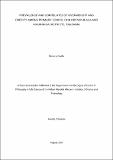| dc.description.abstract | Overweight and obesity are increasing among school children and are currently considered as
significant public health problems. Therefore, this study aimed to determine the prevalence of
overweight and obesity in school children (10-13 years) and their correlates, to inform policy
for action in order to reduce the magnitude and consequences of the problems. A cross sectional study design was conducted in Ilala and Mkuranga districts of Tanzania between July
2019 and December 2020 among 406 school children, 36 parents/guardians, and 9 teachers.
Standardized questionnaires were used for data collection and laboratory analysis was
performed to determine actual fatty acids and sugar contents of foods commonly consumed by
school children in the study areas. Height and weight measurements were performed by using
the World Health Organization standard procedures. The general prevalence of overweight and
obesity based on BMI-for-age indicator was 22.6% higher in private than in public schools
(32.4% vs. 14.8%, p<0.001). Dietary habits of school children were characterized by low fruit,
vegetable, and milk intake. Overweight and obesity among school children correlated
significantly with moderate consumption of soda/carbonated drinks (AOR 0.38, 95% CI 0.19-
0.85), high consumption of fruit/fruit-flavored juices (AOR 0.21, 95% CI 0.07-0.67), local ice
cream (AOR 0.41, 95% CI 0.17-0.95), and low dietary diversity (AOR 0.57, 95% CI 0.44-
0.75). Other predictors were moderate consumption of potato chips (AOR 2.27, 95% CI 1.07-
4.81) and having overweight/obese parent (AOR 10.11, 95% CI 2.72-37.65). In addition,
sedentary behavior, such as listening to music and/or radio for >2 hours/week (OR 2.7, 95%
CI 1.2-6.1) and low physical activity such as walking for exercise <2 hours/week (OR 2.1, 95%
CI 1.1-4.1) were risk factors for overweight/obesity while rope skipping for >2 hours/week
(OR 0.14, 95% CI 0.03-0.7) was protective. Saturated fatty acids, such as palmitic acid (C16:0),
were found in abundance in all food samples while sucrose and saccharin concentrations varied
considerably between products. Findings from this study showed that the food environment
may be a contributing factor to overweight/obesity among school children. This study informs
relevant authorities to take appropriate actions to minimize health risks associated with
overweight and obesity in school children. | en_US |

